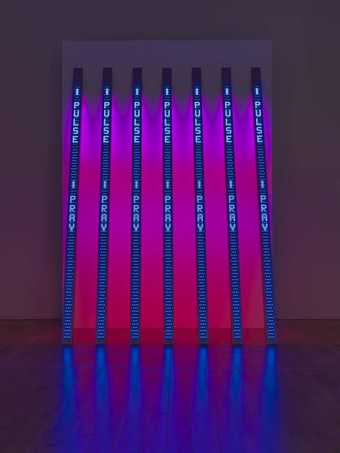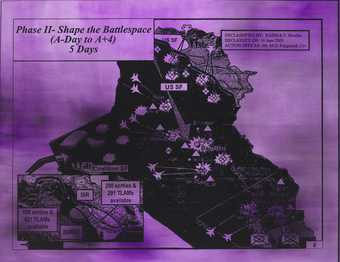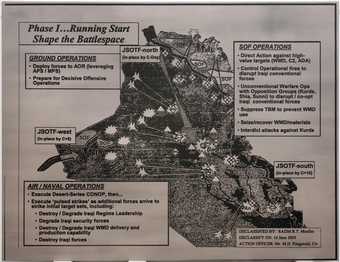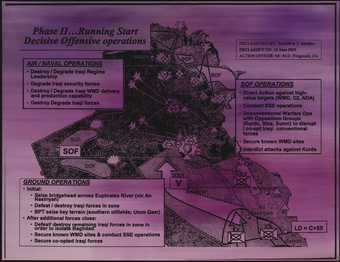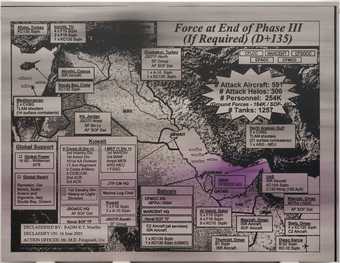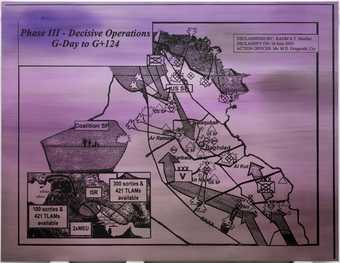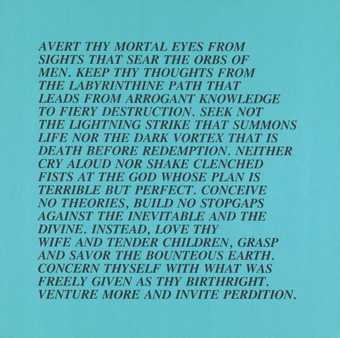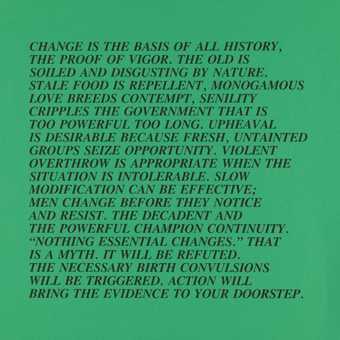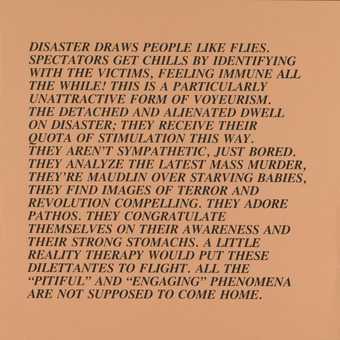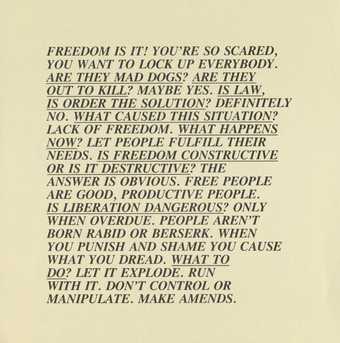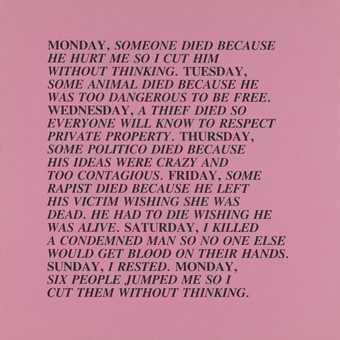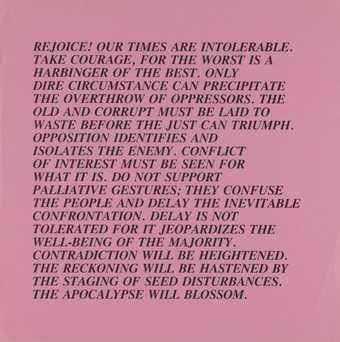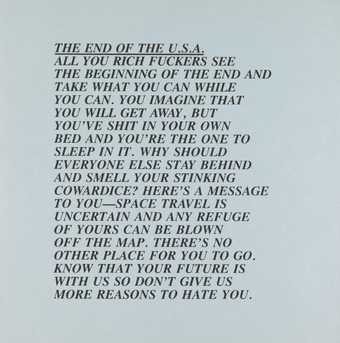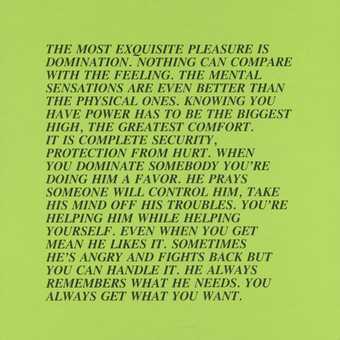
Not on display
- Artist
- Jenny Holzer born 1950
- Medium
- Oil paint on canvas
- Dimensions
- Support: 2011 × 2600 × 40 mm
- Collection
- ARTIST ROOMS Tate and National Galleries of Scotland
- Acquisition
- ARTIST ROOMS Acquired jointly with the National Galleries of Scotland through The d'Offay Donation with assistance from the National Heritage Memorial Fund and the Art Fund 2008
- Reference
- AR00083
Summary
In this work by American artist Jenny Holzer, an image of a military map of Iraq has been screen-printed onto a linen canvas covered in a thin, translucent layer of violet oil paint. The map was first photocopied onto clear film, called a photo-stencil, which was used in the screen-printing process to transfer the image onto the canvas. The map features various labels, arrows and symbols. Three signs for military jets point towards the capital city of Baghdad, which lies almost at the centre of the screen print. Three labels reading ‘Protect’ frame the north, west and south sides of the map (where Iraq borders Turkey, Jordan and Saudi Arabia respectively). Around the map are various instructional labels, with the words ‘Suppress’, ‘Fix’, ‘Seize’, ‘Isolate’, ‘Shock and Awe’, ‘Exploit’ and ‘Gain Control’. (‘Shock and awe’ was a phrase used by the American government to describe its tactic of using overwhelming power during the invasion of Iraq in 2003.) These instructions suggest the defensive and offensive strategies of a military force. A box in the top right-hand corner notes details of the image’s declassification in June 2006.
This large-scale canvas is part of Holzer’s Redaction Paintings series, which the artist began in 2006. It is one of six works from this series in the ARTIST ROOMS collection. Material for this series came from declassified US government documents, particularly those concerning national security, economic policy and foreign relations. Holzer began to use US government files in her work in 2004, taking advantage of the US 1966 Freedom of Information Act, which allows any requesting member of the public to view declassified documents. Redaction refers to the censoring of information in a text, and as the title of the series of Redaction Paintings suggests, Holzer’s images were based on documents redacted by the US government before being made publicly available. Many of the source documents used in the series were made almost entirely illegible through the work of censors before their release, but this appears not to have been the case with the source image used for Protect Protect, which has only two lines of text crossed out. Holzer’s use of a photo-stencil to screen-print the image of the map allowed every element of the document to be reproduced in all its original detail.
Protect Protect makes no explicit critique of its subject matter, but by taking this map out of its military context and holding it up to public scrutiny in an art gallery, Holzer probes the boundaries between transparency and censorship, inviting viewers to reflect upon documentary evidence that offers an alternative reality to the images of war presented in the mass media, while avoiding sensationalist images or the direct representation of violence. The artist has explained her motivation to make such work: ‘As one becomes habituated to things, their intensity is dulled … in the last decades of the twentieth century, political rhetoric on all sides became so strident and inflated that obliqueness and artful understatement proved the most effective means of catching the attention of a weary public.’ (Storr 2006, p.14.)
Described by the art critic Robert Storr as ‘a verbal maze of specialised terminology, acronyms, abbreviations, rote salutations and initials’ (Storr 2006, p.8), the Redaction Paintings were the first works on canvas Holzer exhibited in her career. Before this, she was known primarily for her language-based works, involving a variety of media including posters, LED screen works and projections.
Further reading
Robert Storr, Jenny Holzer: Redaction Paintings, New York 2006.
Cathy Lebowitz, ‘Protect Us From What We Don’t Know’, Art in America, vol.94, no.9, October 2006, pp.162–6.
Jenny Holzer: Protect Protect, exhibition catalogue, Museum of Contemporary Art Chicago 2010.
Florence Ritter
January 2012
Does this text contain inaccurate information or language that you feel we should improve or change? We would like to hear from you.
Online caption
Holzer’s works have a strong political emphasis, questioning how information is both controlled and received in the public domain. First exhibited at the Venice Biennale in 2007, 'Protect Protect' forms part of a series of screenprints that reveal sensitive government transcripts relating to America’s intervention in the Middle East. Here Holzer uses a document from the National Security Archive, enlarging a military map and setting it upon a bright background. Holzer’s technique forces us to acknowledge the interpretative power of language, where the words "protect", "suppress" and "isolate" emanate strongly against the image of a deeply divided and segregated Iraq.
Explore
- abstraction(8,615)
-
- non-representational(6,161)
-
- text(1,043)
- formal qualities(12,454)
-
- diagrammatic(799)
- social comment(6,584)
-
- colonialism(429)
- inscriptions(6,664)
-
- arrow(29)
- map(56)
- printed text(1,138)
You might like
-
Jenny Holzer BLUE PURPLE TILT
2007 -
Jenny Holzer Shape the Battlespace
2007 -
Jenny Holzer Phase I... Running Start Shape the Battlespace pewter
2007 -
Jenny Holzer Phase II... Running Start Decisive Operations violet
2007 -
Jenny Holzer Force at End of Phase III (If Required) violet
2007 -
Jenny Holzer Phase III - Decisive Operations violet
2007 -
Jenny Holzer [no title]
1979–82 -
Jenny Holzer [no title]
1979–82 -
Jenny Holzer [no title]
1979–82 -
Jenny Holzer [no title]
1979–82 -
Jenny Holzer [no title]
1979–82 -
Jenny Holzer [no title]
1979–82 -
Jenny Holzer [no title]
1979–82 -
Jenny Holzer [no title]
1979–82 -
Jenny Holzer Truisms
1984

